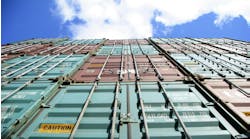Modern Manufacturing Requires Modern Supply Chains
Advancements in technology coupled with the U.S. economic rebound have created an environment in the U.S. manufacturing sector where many companies are investing in capital equipment and new software at unprecedented rates. According to the Association for Manufacturing Technology, 2012 was the best year for U.S. manufacturing technology orders since 1996. Also, we have entered an era where, for the first time, many of the capital investments that were previously considered out of reach for small and middle-market manufacturers have now become economically feasible.
If the time is right for U.S. manufacturers of all sizes to consider modernizing their operations, it is important to first look at modernizing their supply chain and logistics operations in order to optimize potential investments. Manufacturers must think holistically about their business before making these decisions, and this includes looking at their supply chain and distribution models and the impacts of these investments on their operations.
To begin, manufacturers should ask themselves how making capital investments—whether updating equipment, manufacturing processes, software solutions, or even supply chain functions—will impact their inventory, customer demand, sourcing strategy and distribution models. Efforts to modernize manufacturing through initiatives such as automation, the integration of cloud-based technologies, the incorporation of additive manufacturing and even the utilization of data management tools all can have an impact on a manufacturer’s overall supply chain operations. Below are several aspects of modernizing that manufacturers need to know to prepare for the future.
Automation and Robotics
While the manufacturing sector—specifically the U.S. automotive, industrial and food manufacturing industries—has focused on automation and robotics for decades, advancements in technology have made new automated and robotic resources available to many small and mid-market manufacturers for the first time. Adopting those solutions can position companies for increased efficiency, production speeds and reduced costs. However, it is important to evaluate whether inbound and outbound supply chains can keep pace with the improvements.
A few questions manufacturers should be asking themselves before embarking on automation updates:
- Can inbound raw materials and parts maintain proper inventory levels, buffers, reorder points and lead times associated with automated production?
- Can existing freight and distribution assets keep up with this production as well?
- If new automated solutions require maintenance, does a company’s existing service model allow for quick repair, or will companies be looking at extended downtimes?
By partnering with logistics providers with access to multiple modes of transportation and large distribution networks, manufacturers can more easily adjust to the increased supply chain demands and output resulting from the implementation of automated processes. Logistics providers can provide access to a network of field-stocking locations to support technicians and assist with faster maintenance or service of automated equipment.
Cloud Technologies
Many manufacturers have begun to look to cloud technologies as a way to modernize. Cloud enterprise resource planning (ERP) and cloud-based applications can increase efficiency across manufacturing operations, especially when manufacturing is occurring in multiple locations. By outsourcing much of the software and data storage with cloud ERP, manufacturers can reduce IT and related expenses.
The increased visibility and standardization resulting from cloud technologies can also make it easier to bring new manufacturing operations online from anywhere in the world, even emerging markets. However, manufacturers must evaluate whether these regions have the proper transportation infrastructure in place for supply chain operations that could support manufacturing. This means easy access to multi-modal freight, shipping, warehousing and distribution solutions.
Additionally, many retailers and distributors are evaluating cloud-based supplier management platforms that provide real-time supply chain oversight. Such platforms require manufacturers to feed order status information a cloud-based solution to increase customer inbound visibility. With faster access and visibility into the status of shipments, manufacturers’ customers can better plan and anticipate inventory levels and reduce customer service inquiries into the status of orders.
Additive Manufacturing
One area of manufacturing getting much attention is additive manufacturing, also known as 3-D printing. Price points for this technology have made it easier for smaller manufacturers to incorporate 3-D printing into their operations. Now, many can justify the production of customized, low volume products or take prototyping one step further, through the actual production of new parts and solutions.
The relative affordability of 3-D printing solutions also has made this technology more accessible to new markets. As a result, manufacturers of 3-D printers are turning to e-commerce channels to sell and fulfill their products to these new markets. The shift in selling channels now requires consideration of factors such as the integration of e-commerce and shipping and tracking tools into websites, and balancing the management of traditional distribution channels with digital channels.
Analyzing Big Data
With the ability to now capture massive amounts of data and information related to operations, manufacturers also may benefit from analyzing this information which can be used to make strategic, fact-based decisions, and even develop predictive modeling. Imagine the competitive advantage of being able to predict inventory needs with near certainty, anticipate and address supply chain problems before any impact is felt, or even anticipate online customer needs. The insight drawn from these tools can be immensely powerful.
While data management tools could certainly enhance a company’s competitive position, success will require having the supply chain and distribution networks that can meet and capitalize on the anticipated needs. In this highly specialized area, it is common for companies to enlist the help of experts and consultants. In fact, many lean heavily on companies like UPS for these services.
Modern Manufacturers Face Unprecedented Challenges
In an era of technological advancements and large leaps in the modernizing of manufacturing, companies still face a number of challenges including faster product life cycles and increasing cost pressures. These trends often are at odds with each other, with one supporting the near-sourcing of suppliers and re-shoring of manufacturing to reduce supply chain lead times and quickly address demand, while the other leads manufacturers to outsource some (or all) of their operations to overseas markets to reduce labor and overhead costs.
Your logistics provider can help. The most effective way to strike a balance between these two seemingly opposing demands is through the modernization of their supply chain operations. Specifically, manufacturers that outsource portions or all of their supply chains and distribution activities to a third-party logistics provider with the experience and global reach to conduct a comprehensive supply chain analysis and implement modern supply chain enhancements will be in a better position to compete with larger companies when it comes to capitalizing on modernization initiatives.
When looking for a logistics partner, manufacturers should ensure that they focus on companies with access to flexible multi-modal transportation options and distribution solutions and experience navigating the regulations and additional challenges of overseas markets to successfully minimize lead times and help manufacturers reduce costs.
The Future is Now?
Capital investment decisions have been anything but easy for quite some time. As a result, U.S. companies are more cash-rich than at any time in modern history. Manufacturers, faced with the prospect of investing in new technologies and equipment to remain competitive must soon answer many large and complicated questions, like this:
“How will modernizing manufacturing operations affect my supply chain?”
The question seems easy enough, but like throwing a pebble in a pond, every modernization decision will ripple further than anyone could imagine. Will improved throughput increase inventory demands and strain my supply base? Will equipment upgrades change the way we package? The mode and speed we have to ship? How will new technologies impact the workforce?
Unfortunately, there are no quick answers, but there is help. Inviting your logistics partners to the earliest stages of your purchase considerations can mean the difference between getting a return on your investment dollars, and leaving cash on the table.
Charlie Chung is the industrial manufacturing marketing manager at global logistics services provider UPS.




